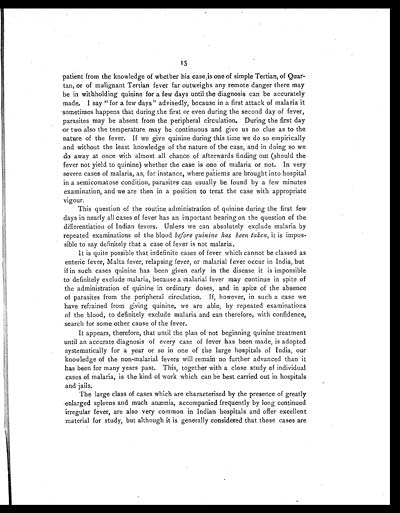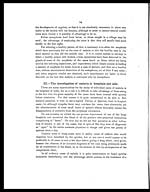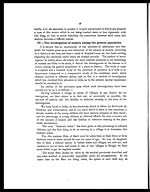Medicine - Institutions > Army health reports and medical documents > Scientific memoirs by officers of the Medical and Sanitary Departments of the Government of India > Number 2 - Malaria in India > Part I > Methods of investigation
(23) Page 15
Download files
Individual page:
Thumbnail gallery: Grid view | List view

15
patient from the knowledge of whether his case is one of simple Tertian, of Quar-
tan, or of malignant Tertian fever far outweighs any remote danger there may
be in withholding quinine for a few days until the diagnosis can be accurately
made. I say "for a few days" advisedly, because in a first attack of malaria it
sometimes happens that during the first or even during the second day of fever,
parasites may be absent from the peripheral circulation. During the first day
or two also the temperature may be continuous and give us no clue as to the
nature of the fever. If we give quinine during this time we do so empirically
and without the least knowledge of the nature of the case, and in doing so we
do away at once with almost all chance of afterwards finding out (should the
fever not yield to quinine) whether the case is one of malaria or not. In very
severe cases of malaria, as, for instance, where patients are brought into hospital
in a semicomatose condition, parasites can usually be found by a few minutes
examination, and we are then in a position to treat the case with appropriate
vigour.
This question of the routine administration of quinine during the first few
days in nearly all cases of fever has an important bearing on the question of the
differentiation of Indian fevers. Unless we can absolutely exclude malaria by
repeated examinations of the blood before quinine has been taken, it is impos-
sible to say definitely that a case of fever is not malaria.
It is quite possible that idefinite cases of fever which cannot be classed as
enteric fever, Malta fever, relapsing fever, or malarial f ever occur in India, but
if in such cases quinine has been given early in the disease it is impossible
to definitely exclude malaria, because a malarial fever may continue in spite of
the administration of quinine in ordinary doses, and in spite of the absence
of parasites from the peripheral circulation. If, however, in such a case we
have refrained from giving quinine, we are able, by repeated examinations
of the blood, to definitely exclude malaria and can therefore, with confidence,
search for some other cause of the fever.
It appears, therefore, that until the plan of not beginning quinine treatment
until an accurate diagnosis of every case of fever has been made, is adopted
systematically for a year or so in one of the large hospitals of India, our
knowledge of the non-malarial fevers will remain no further advanced than it
has been for many years past. This, together with a close study of individual
cases of malaria, is the kind of work which can be best carried out in hospitals
and jails.
The large class of cases which are characterised by the presence of greatly
enlarged spleens and much anæmia, accompanied frequently by long continued
irregular fever, are also very common in Indian hospitals and offer excellent
material for study, but although it is generally considered that these cases are
Set display mode to: Large image | Zoom image | Transcription
Images and transcriptions on this page, including medium image downloads, may be used under the Creative Commons Attribution 4.0 International Licence unless otherwise stated. ![]()
| Permanent URL | https://digital.nls.uk/75022418 |
|---|
| Shelfmark | IP/QB.10 |
|---|---|
| Additional NLS resources: | |




